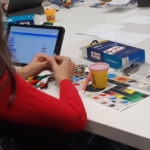Female role models for the scientists of the future
The numbers have spoken: women represent less than 30 percent of those registering for higher education degrees in science, technology, engineering and mathematics (STEM) fields. UNESCO data show that female scientists make up 28 percent of all scientists on a global level. This gap begins in the early years of girls’ education, when they start to distance themselves from sciences. How can we change this trend?

“Today we are going to program a spaceship”. This is how the workshop “Women in science and technology” begins. The session is organized by BBVA and #girlsgonna, an educational initiative of the Everis group to bridge the gender gap in the digital sector. A group of 23 children, accompanied by their parents, starts putting on their imaginary space suit to conquer the moon. They are led by Margaret Hamilton, the team leader who programmed the code for Apollo 11 to reach the moon, showing the children the programming world up close with a woman in the leading role.
The lack of female role models in STEM fields is one of the reasons girls are discouraged from imagining themselves in these kinds of professions.
Showing girls examples of women in history who have broken down these stereotypes can bring them closer to STEM fields and encourage them to consider degrees in science or technology.
The workshops are a learning experience in which the children between the ages of seven and 12 have fun programming a trip to the moon with their parents. Using simple command codes they are able to land their personal spaceship, with the help of a circuit they build themselves.
This activity is part of BBVA’s diversity and inclusion program, which aims to promote STEM professions among girls and break down the gender stereotypes associated with certain areas of knowledge. BBVA has held a total of six workshops like this one for over 100 sons and daughters of bank employees at the headquarters in Madrid. And there are more to come. The initiative will be repeated in Spain, and in the coming weeks, in Mexico to reach 60 families.
We don’t know how many of these girls will be the astronauts, programmers or scientists of the future. But we do know that with an education that breaks down stereotypes and gender biases, they can go as far as they choose. Even to the moon.